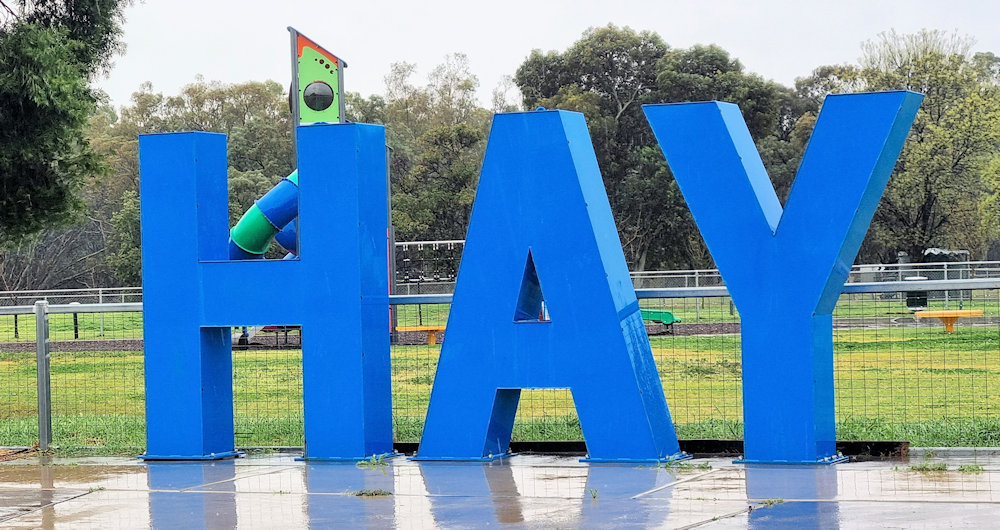Hay New South Wales
Located in the western Riverina region of south-western New South Wales, Australia, Hay is roughly half way between Sydney and Adelaide. This makes it an ideal stop over for anyone travelling between these two cities.
Hay began in the 1850s as Lang’s Crossing Place, a vital point for stock travelling between Victoria and New South Wales. Traders recognised the importance of the river crossing, and officials soon formalised the settlement, naming it after political figure John Hay. As pastoral activity expanded across the western plains, the town gained significance as a commercial and administrative centre.
River transport advanced this rise. Paddle steamers carried wool and supplies along the Murrumbidgee, and Hay became a prominent stop in the network. Then, in 1882, the railway reached the town and accelerated its growth. Rail freight supported pastoral stations across the district, and businesses developed around the new facilities. These changes established Hay as a durable hub that linked land transport, river movement and rural production.
During the Second World War, the Commonwealth established internment and prisoner-of-war camps around Hay due to the town’s isolation and logistical advantages. The arrival of the Dunera internees in 1940, followed by Italian prisoners of war, created a significant wartime chapter that continues to inform local memory. Today, the former railway station houses the Dunera Museum, which interprets this complex history.
Modern Hay
Hay now serves as a regional centre for agriculture, transport and tourism. Wool, beef, lamb, cotton and irrigated crops form the economic base, and the town supplies labour, services and infrastructure to surrounding properties. Furthermore, three major highways intersect at Hay, which strengthens freight movement and supports commercial activity.
Tourism contributes steadily to the local economy. Visitors explore heritage sites, including the Hay Gaol, Bishop’s Lodge and the river precincts, while cultural institutions such as Shear Outback highlight regional identity. Public art, particularly the water tower murals, and statues in the main street add another reason to look around the town.

Mrs McGrath and Her Pet Sheep
During the 1920s and 30s, Mrs McGrath regularly charged drovers a small fee for her, and her pet sheep’s service to lead their mobs of Merinos across the bridge.
When the large mobs of sheep came through Hay, drovers had difficulty getting them over the bridge, so Mrs McGrath used a pet sheep to lead the mob onto the bridge, from where they happily followed her into Lachlan Street.
Located outside the post office in Lachlan Street, the sculptures celebrate Mrs McGrath and the sheep.


Sheep Reading a Book Outside the Library

Emu Statues
There are several spots around Hay with emu sculptures. As you drive around the area, you will probably see live ones off the side of the road.

Battle of Beersheba Centenary Memorial
On October 31, 1917, the 4th and 12th Australian Light Horse Regiments made history in what would become Australia’s first great World War One victory and the last successful cavalry charge. These horsemen stormed through Turkish defences at dusk to capture the strategic town of Beersheba. Erected to commemorate the centenary of the battle, the memorial has a bronze sculpture of a Waler (the breed of horse predominantly used in the Light Horse Brigades), and his soldier. Located on the corner of Pine & Morgan Streets, Hay.

Dunera Museum
The Dunera Museum in Hay explores one of Australia’s most unusual wartime stories. It sits in a restored railway station that once received more than two thousand refugees from Europe in 1940. These men travelled on the HMT Dunera after Britain sent them abroad as “enemy aliens.” However, most were Jewish refugees who had fled Nazism. The museum now explains their journey and their impact on Australia.
The full blog and description of the Dunera Museum can be found here.

Hay Gaol
Built in the late 1870s and officially opened in 1880, Hay Gaol has served as a prison, maternity hospital, Prisoner of War detention centre, institute for girls and now as a museum.
The full blog and description of Hay Gaol can be found here.

Shear Outback
Shear Outback, located in Hay, New South Wales, is an award-winning cultural centre dedicated to the Australian shearing industry. Established to formally recognize the immense contribution of shearers and the wool trade to the nation’s development, the facility offers visitors a detailed and active experience. Situated at the junction of major highways, this is a must-see destination for anyone interested in Australian rural history.
The full blog and description of Shear Outback can be found here.

Hay Water Tower Art
The portraits of six individuals who served in the Second World War adorn the water towers, designed to represent the hundreds of people from this tiny community who answered the call to arms. The veterans depicted are Private William ‘George’ Cannon, Corporal Cliff Farlow, Lance Corporal Mervyn Farrands, Private Norman Flack, Lieutenant Lorna Margaret Whyte from the Australian Army Nursing Service and Indigenous soldier Private Victor George Murray.
The full blog and description of the water towers can be found here.

Other Places to Visit in New South Wales
To see what else there is to do in New South Wales, click here.
Our photos are available for purchase on

Leave a Reply